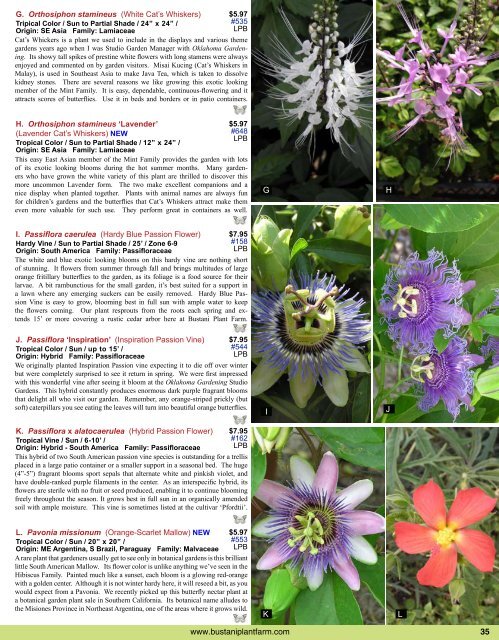Download Catalog - Bustani Plant Farm
Download Catalog - Bustani Plant Farm
Download Catalog - Bustani Plant Farm
You also want an ePaper? Increase the reach of your titles
YUMPU automatically turns print PDFs into web optimized ePapers that Google loves.
G. Orthosiphon stamineus (White Cat’s Whiskers)<br />
Tripical Color / Sun to Partial Shade / 24” x 24” /<br />
Origin: SE Asia Family: Lamiaceae<br />
Cat’s Whickers is a plant we used to include in the displays and various theme<br />
gardens years ago when I was Studio Garden Manager with Oklahoma Gardening.<br />
Its showy tall spikes of prestine white flowers with long stamens were always<br />
enjoyed and commented on by garden visitors. Misai Kucing (Cat’s Whiskers in<br />
Malay), is used in Southeast Asia to make Java Tea, which is taken to dissolve<br />
kidney stones. There are several reasons we like growing this exotic looking<br />
member of the Mint Family. It is easy, dependable, continuous-flowering and it<br />
attracts scores of butterflies. Use it in beds and borders or in patio containers.<br />
H. Orthosiphon stamineus ‘Lavender’<br />
(Lavender Cat’s Whiskers) NEW<br />
Tropical Color / Sun to Partial Shade / 12” x 24” /<br />
Origin: SE Asia Family: Lamiaceae<br />
$5.97<br />
#535<br />
LPB<br />
This easy East Asian member of the Mint Family provides the garden with lots<br />
of its exotic looking blooms during the hot summer months. Many gardeners<br />
who have grown the white variety of this plant are thrilled to discover this<br />
more uncommon Lavender form. The two make excellent companions and a<br />
nice display when planted together. <strong>Plant</strong>s with animal names are always fun<br />
for children’s gardens and the butterflies that Cat’s Whiskers attract make them<br />
even more valuable for such use. They perform great in containers as well.<br />
I. Passiflora caerulea (Hardy Blue Passion Flower)<br />
Hardy Vine / Sun to Partial Shade / 25’ / Zone 6-9<br />
Origin: South America Family: Passifloraceae<br />
$5.97<br />
#648<br />
LPB<br />
The white and blue exotic looking blooms on this hardy vine are nothing short<br />
of stunning. It flowers from summer through fall and brings multitudes of large<br />
orange fritillary butterflies to the garden, as its foliage is a food source for their<br />
larvae. A bit rambunctious for the small garden, it’s best suited for a support in<br />
a lawn where any emerging suckers can be easily removed. Hardy Blue Passion<br />
Vine is easy to grow, blooming best in full sun with ample water to keep<br />
the flowers coming. Our plant resprouts from the roots each spring and extends<br />
15’ or more covering a rustic cedar arbor here at <strong>Bustani</strong> <strong>Plant</strong> <strong>Farm</strong>.<br />
J. Passiflora ‘Inspiration’ (Inspiration Passion Vine)<br />
Tropical Color / Sun / up to 15’ /<br />
Origin: Hybrid Family: Passifloraceae<br />
$7.95<br />
#158<br />
LPB<br />
We originally planted Inspiration Passion vine expecting it to die off over winter<br />
but were completely surprised to see it return in spring. We were first impressed<br />
with this wonderful vine after seeing it bloom at the Oklahoma Gardening Studio<br />
Gardens. This hybrid constantly produces enormous dark purple fragrant blooms<br />
that delight all who visit our garden. Remember, any orange-striped prickly (but<br />
soft) caterpillars you see eating the leaves will turn into beautiful orange butterflies.<br />
K. Passiflora x alatocaerulea (Hybrid Passion Flower)<br />
Tropical Vine / Sun / 6-10’ /<br />
Origin: Hybrid - South America Family: Passifloraceae<br />
$7.95<br />
#544<br />
LPB<br />
This hybrid of two South American passion vine species is outstanding for a trellis<br />
placed in a large patio container or a smaller support in a seasonal bed. The huge<br />
(4”-5”) fragrant blooms sport sepals that alternate white and pinkish violet, and<br />
have double-ranked purple filaments in the center. As an interspecific hybrid, its<br />
flowers are sterile with no fruit or seed produced, enabling it to continue blooming<br />
freely throughout the season. It grows best in full sun in an organically amended<br />
soil with ample moisture. This vine is sometimes listed at the cultivar ‘Pfordtii’.<br />
L. Pavonia missionum (Orange-Scarlet Mallow) NEW<br />
Tropical Color / Sun / 20” x 20” /<br />
Origin: ME Argentina, S Brazil, Paraguay Family: Malvaceae<br />
$7.95<br />
#162<br />
LPB<br />
$5.97<br />
#553<br />
LPB<br />
A rare plant that gardeners usually get to see only in botanical gardens is this brilliant<br />
little South American Mallow. Its flower color is unlike anything we’ve seen in the<br />
Hibiscus Family. Painted much like a sunset, each bloom is a glowing red-orange<br />
with a golden center. Although it is not winter hardy here, it will reseed a bit, as you<br />
would expect from a Pavonia. We recently picked up this butterfly nectar plant at<br />
a botanical garden plant sale in Southern California. Its botanical name alludes to<br />
the Misiones Province in Northeast Argentina, one of the areas where it grows wild.<br />
G<br />
I<br />
K<br />
www.bustaniplantfarm.com 35<br />
H<br />
J<br />
L


